Coronavirus (COVID-19): state of the epidemic - 23 April 2021
This report brings together the different sources of evidence and data about the coronavirus epidemic to summarise the current situation, why we are at that place, and what is likely to happen next.
This document is part of a collection
State of the Epidemic in Scotland – 23rd April 2021
Background
This report summarises the current situation on the COVID-19 epidemic in Scotland. It brings together the different sources of evidence and data about the epidemic in Scotland at this point in time, why we are at that place, and what is likely to happen next. This summarises the data up to and including the 22 April 2021 on COVID-19 in Scotland. This updates the previous publication published on 16 April 2021[1]. The information in this document helps the Scottish Government, the health service and the wider public sector respond to the epidemic and put in place what is needed to keep us safe and treat people who have the virus.
This edition of the state of the epidemic, summarises current data on COVID-19 at a national level, at a local level and how Scotland currently compares to the rest of the UK. It looks at the vaccination program in Scotland and the effects which are beginning to be seen from this. Information is provided about variants of concern and what impact these may have. Bringing this information together in one place gives the opportunity to better understand the current state of the epidemic in Scotland.
Key Points
- The reproduction rate R in Scotland is currently estimated as being between 0.7 and 0.9. This is lower than last week.
- An average of 220 cases were reported per day in the 7 days to 22 April, which is a 12% decrease in reported cases since the 15 April.
- There were 28 weekly cases per 100,000 in the week to 19 April, which is a decrease since last week. This compares to 302 weekly cases per 100,000 on 8 January and is similar to the weekly case rate observed on 16 September.
- Case rates saw the sharpest decrease in those aged 40-59, however a slight increase in case rates in those aged 60+ this week (normal small fluctuation in low case numbers).
- The estimated proportion of people becoming infected with Covid in Scotland has continued to decrease in the most recent week and is currently above England, Northern Ireland and Wales as determined through the latest weekly ONS survey.
- Latest modelled estimates suggest there are currently between 4 and 18 new daily infections per 100,000 people in Scotland.
- Deaths involving coronavirus have declined most in those aged 15-44 over the 3 weeks to 18 April, having gone down by 100% (as a result of deaths going down from 2 to 0). Deaths in those aged 75-84, 65-74, 85+ and 45-64 have declined by 83%, 75%, 45% and 42% respectively over the same period.
- Average daily deaths per 100,000 population in Scotland (0.03) are level with England (0.03), and below Northern Ireland (0.06) and Wales (0.04).
- Clackmannanshire currently has the highest weekly case rate in Scotland reporting 70 cases per 100,000 in the last week, while Argyll and Bute, Midlothian, East Lothian, Dumfries and Galloway, and Scottish Borders reported fewer than 10 weekly cases per 100,000 each in the same time. Na h-Eileanan Siar, Orkney and Shetland had 0 cases per 100,000 in the last week.
- At a national level hospital bed and ICU occupancy are projected to fall over the next few weeks, but these both may plateau or increase as a result of schools reopening and other relaxations of non-pharmaceutical interventions.
- Over 2.7 million people in Scotland have been given a first vaccine against SARS-CoV-2, and over 898,000 have now received a second dose.
- The current UK variant of concern remains the dominant strain.
Method
This report brings together a wide range of publically available figures from a range of data sources. These include publications by Scottish Government, Public Heath Scotland, National Records of Scotland, Office for National Statistics along with scientific publications and SAGE summaries where appropriate to summarise the state of the epidemic in Scotland in a given week. We also provide information on public attitudes to the virus from weekly You Gov polling surveys.
The national picture
The latest R value for Scotland (published on 22 April)[2] was between 0.7 and 0.9 (Figure 1), with a growth rate of between -4% and -1%.
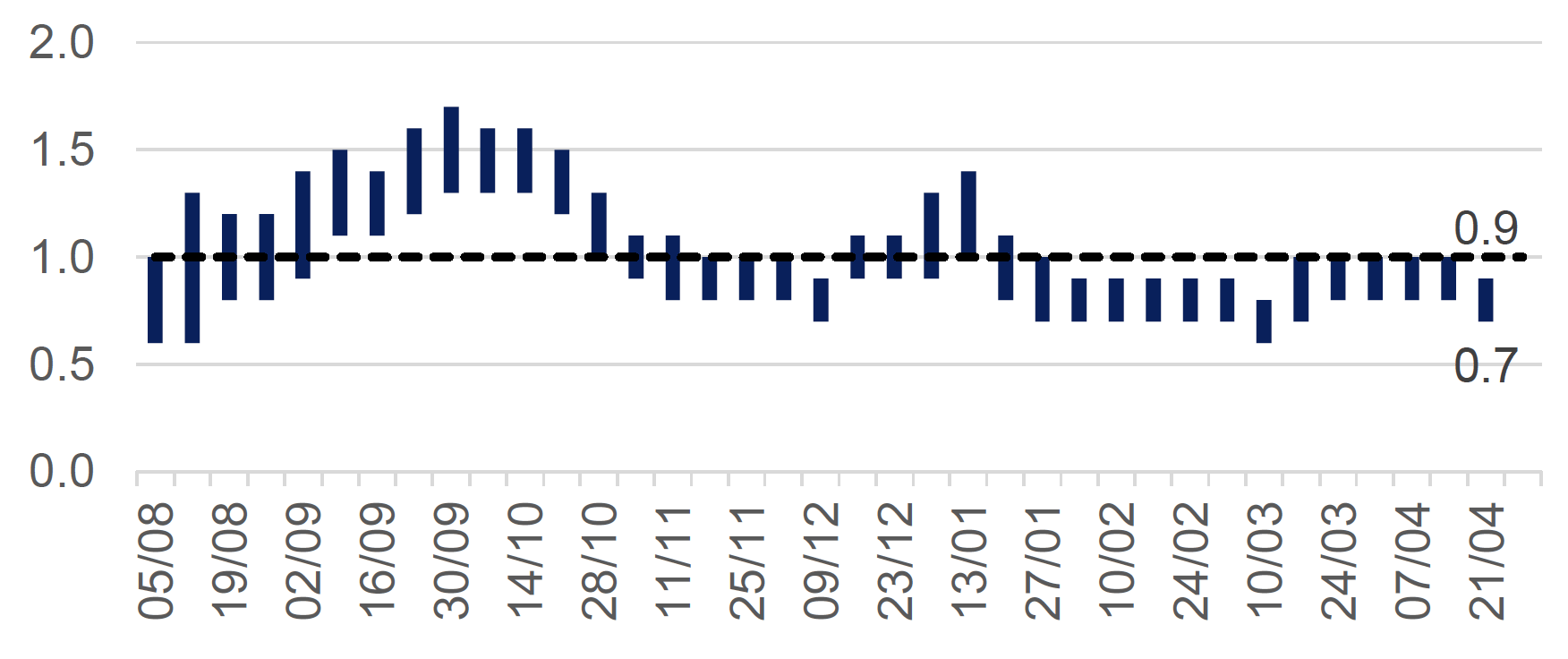
Image Description:
The R number has varied over the pandemic with the estimated range moving above 1 in Autumn 2020 and January 2021. For the number of infectious people to fall we need to keep the R number consistently below 1.
The latest R value for Scotland (published on 22nd April) has decreased to between 0.7 to 0.9 compared to the previous weeks estimate of between 0.8 and 1.0 (Figure 1), with a growth rate of between -4% and -1% implying that the number of infectious people is still falling.
As Scotland started to move out of national level stay at home measures, an average of 220 cases were reported per day in the 7 days to 22 April. This is a 12% decrease from the daily average cases recorded a week earlier to 15 April[3]. Average daily cases reported are now under a tenth of the peak of 2,323 in the week to 7 January. Our current position is 28 weekly cases per 100,000 in the week to 19 April[4]. This compares to 302 weekly cases per 100,000 on 8 January and is similar to the weekly case rate observed on 16 September (see Figure 2)[4].
The number of locations where the levels of Covid in wastewater are monitored has increased to 103 sites around Scotland. In contrast to COVID-19 case records, virus shedding into wastewater is a biological process. This means that wastewater data is unaffected by factors that impact whether testing is done. The overall level of wastewater RNA this week was again similar to last week, leaving wastewater Covid levels slightly above the rate of new cases in terms of relative levels. This is affected by the fact that normalisation to account for changing dilution levels is not currently possible for the most recent measurements from a few larger sites.
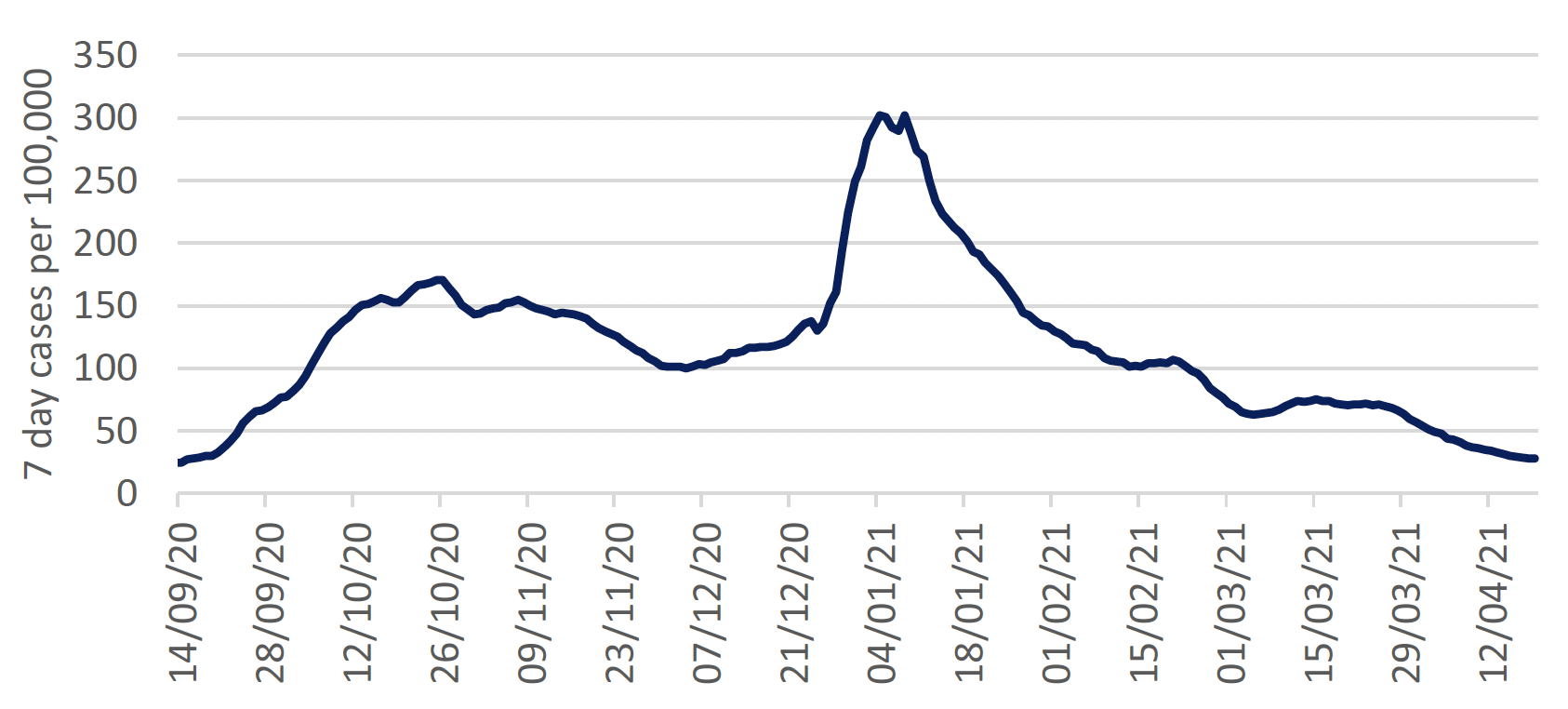
Image Description:
The weekly case rate of diagnosed infection is defined as the number of newly reported, laboratory confirmed cases of SAR-CoV-2 per 100,000 population. This case rate rose from a low of 24.7 in September to 170.1 in October. It then reduced and levelled off at just over 100 by the beginning of December. At the end of December it rose sharply to just over 300 at the start of January.
It has been decreasing since then but three weeks ago there was a small increase and then it plateaued for two weeks. It has started to decrease again in the last three weeks. The weekly case rate is 28 as at 19th April and is now similar to the weekly case rate observed on 16 September.
Case rates saw the sharpest decline in those aged 40-59, however a slight increase in 7 day cases per 100,000 in those aged 60+ this week (normal small fluctuation in low case numbers) (Figure 3).
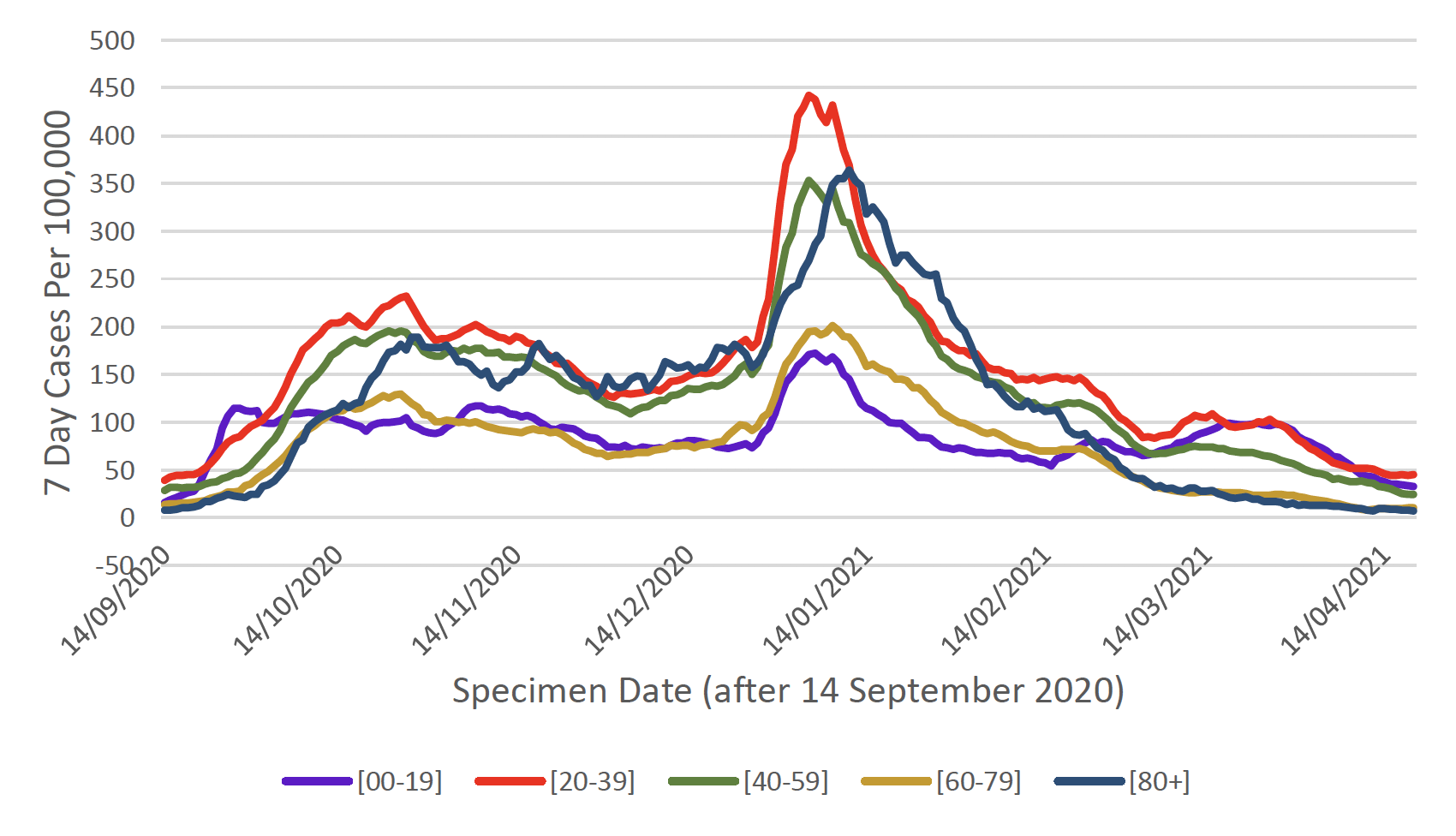
Image Description:
Figure 3 shows the seven day cases per 100,000 for five different age bands over time. Each age band shows a similar trend with a peak in cases in January, with the 20-39 age band having the highest case rate and the 00-19 age band having the lowest case rate. Cases rates reduced in all age group from this peak. Case rates have decreased most in those aged 40-59 this week, and increased slightly in those aged 60+ (normal small fluctuation in low case numbers).
Not everyone who has the virus will be tested, as many people do not realise they have COVID, or have mild symptoms and do not come forward. Latest modelled estimates suggest there are currently anywhere between 200 and 1,000 people infected in Scotland each day[2]. This means that as of 21 April there were between 4 and 18 new daily infections per 100,000 people.
The number of people in hospital with confirmed Covid for less than 28 days is declining. After peaking at 2,053 on 22 January, this figure has decreased and as of 22 April there were 93 patients in hospital with COVID-19. In addition, there was a fall in daily hospital admissions for people with Covid from a peak of 242 on 11 January to 12 on 18 April.
There were 24 deaths registered where Covid was mentioned on the death certificate in the week to 18 April. This is a 29% decrease on the week before (34 deaths), and 96% lower than the peak in April 2020 (663 deaths). The proportion of deaths in care homes has decreased from 36% in mid-December to 25% of total deaths in the week to 18 April. This has increased from 8% in the week to 28 March, however this needs to be interpreted with caution due to low numbers. Deaths involving coronavirus have declined most in those aged 15-44 and have gone down by 100% (as a result of deaths going down from 2 to 0) in this age group over the 3 weeks to 18 April (Figure 4). Deaths in those aged 75-84, 65-74, 85+ and 45-64 have declined by 83%, 75%, 45% and 42% respectively over the same period.
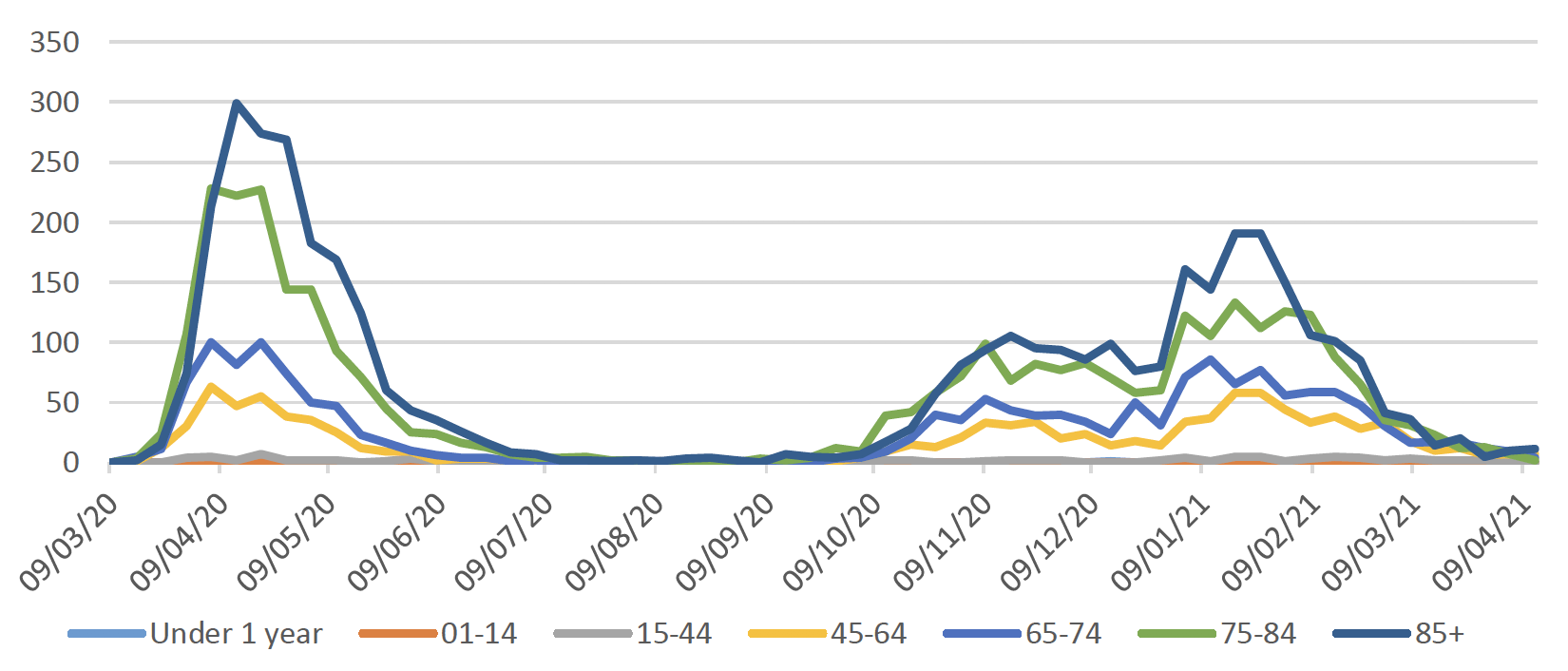
Image Description:
This figure shows the number of deaths over time for seven different age groups. In April 2020 the number of deaths in the four age groups for 45+ reached a peak with the highest number of deaths being in the 85+ group. Deaths then declined steeply and the number of deaths were very low in all age groups during July to September. In October the number of deaths started to increase and then plateaued during November and December for the four age groups 45+. At the end of December deaths rose steeply again to another peak in January with the highest deaths being in the 85+ group. The number of deaths has since declined steeply with the largest decrease in the 85+ age group observed first followed by a sharp decline in the 75-84 age group. Over the last three weeks to 18 April, deaths is those aged 75-84 have gone down by 83%. Similarly in those aged 45-64, 65-74 and over 85+ deaths have gone down by 42%, 75% and 45% respectively. Deaths in the under 44s have remained very low throughout the whole period.
How Scotland compares with the rest of the UK
The latest ONS survey estimates that the proportion of the population infected in the community in Scotland (0.18% people currently testing positive for Covid-19 from 10 -16 April) has continued to decrease in the most recent week. However this is now above England (0.17%), Northern Ireland (0.15%) and Wales (0.12%). In the week to the 16 April the estimated rate of community infection was 1 in 560 people in Scotland, compared to 1 in 610 for England, 1 in 840 for Wales and 1 in 660 for Northern Ireland[8]. Average daily deaths in Scotland (0.03 per 100,000 in the week to 22 April) are level with England (0.03) and below Northern Ireland (0.06) and Wales (0.04). The Coronavirus Infection Survey estimated that in the week to 28 March, 46.0% of the population in Scotland would have tested positive for antibodies against Covid-19. This compares to 54.9% in England, 49.1% in Wales, and 54.5% in Northern Ireland.[9]
Situation by local authority within Scotland
Clackmannanshire currently has the highest case rates in Scotland with 70 weekly cases being reported per 100,000 in the week to 19 April. This is a decrease of 14% from the week to 12 April[4]. There are mostly moderate and low levels of cases across Scotland, with higher levels of cases observed across the central belt (Figure 5). Most Local Authorities recorded a fall in cases in the last week to 19 April. Argyll and Bute, Midlothian, East Lothian, Dumfries and Galloway, and Scottish Borders each have fewer than 10 weekly cases per 100,000. Shetland, Na h-Eileanan Siar and Orkney had 0 cases per 100,000 in the last week[4].
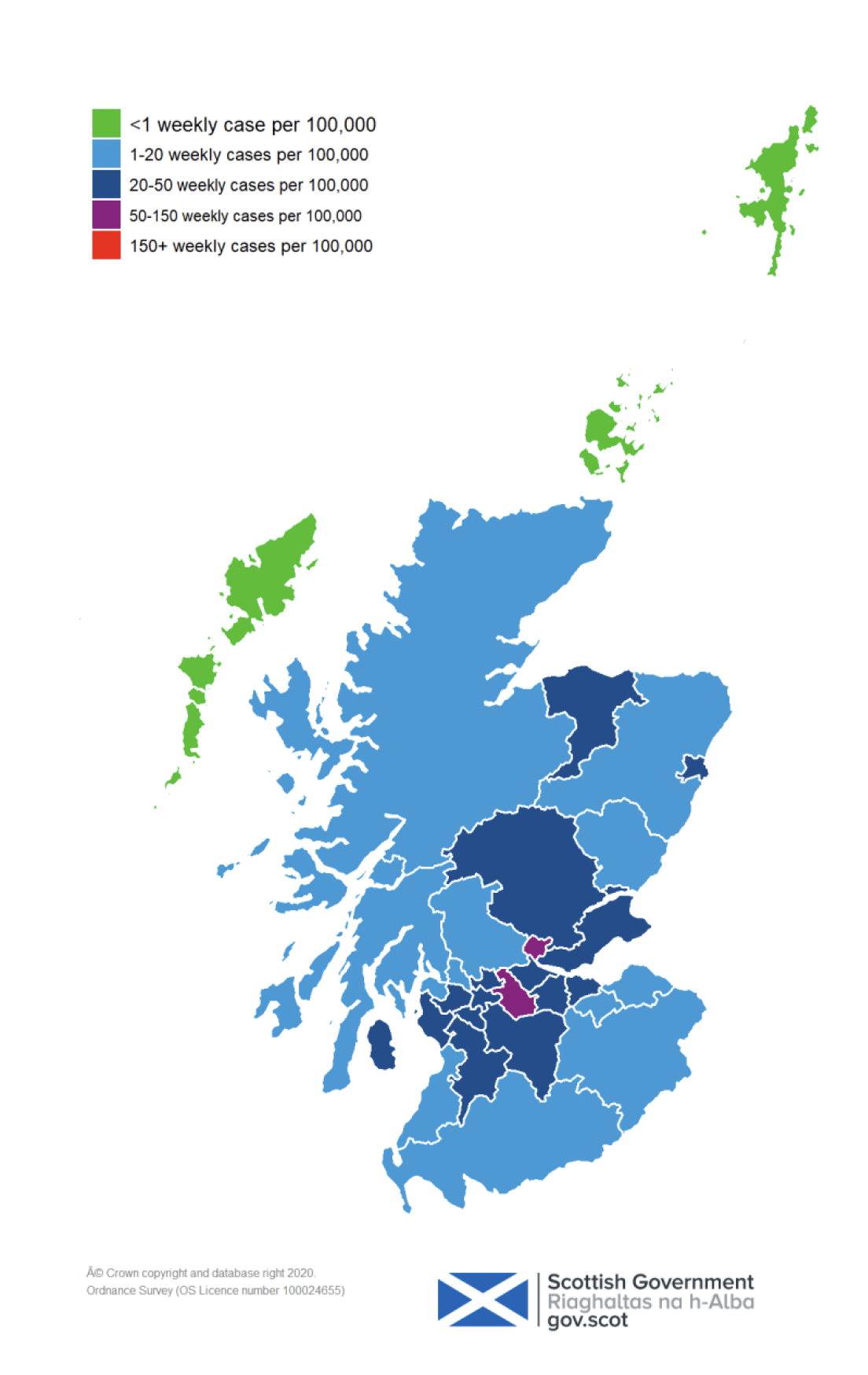
Image Description:
This colour coded map of Scotland shows the different rates of weekly positive cases per 100,000 across Scotland’s Local Authorities. The colours range from green with under 1 weekly case, through light blue with 1 – 20 weekly cases, dark blue 20-50 weekly cases, purple 50-150 weekly cases and red with over 150 weekly cases per 100,000. Clackmannanshire has the highest case rate in Scotland with 70 weekly cases being reported per 100,000 in the week to 19th April. Na h-Eileanan Siar, Orkney and Shetland are showing as green with no cases per 100,000 population. All other Local Authorities are showing as light blue, dark blue or purple.
The most recent modelling predicts that for the week ending 8 May, there are no local authorities with at least a 75% probability exceeding 50 cases per 100,000 population (Figure 6)[2]. This is unchanged from last week.
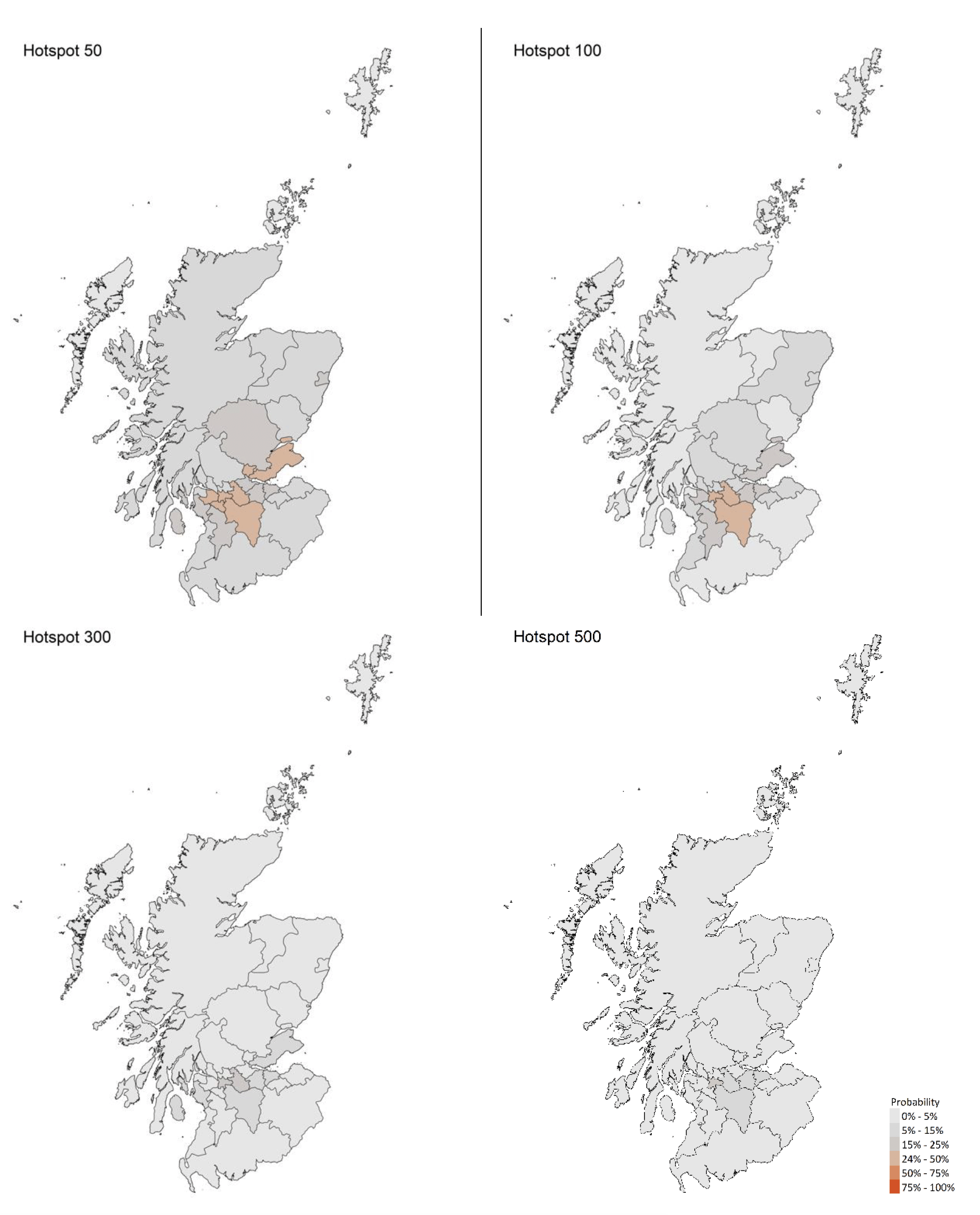
Image Description:
This figure shows the probability of Local Authorities having more than 50, 100, 300 and 500 cases per 100,000 population. Hotspot is defined as an area that is predicted to exceed the cases threshold. The most recent modelling predicts that for the week ending 8 May, there are no local authorities with at least a 75% probability exceeding 50 cases per 100,000 population.
Children and Education
Children in early learning and childcare and those in primaries 1-3 went back to school or nursery on 22 February, and all children in primaries 4-7 went back on the 15 March. There has also been a phased return to secondary schools, with some Senior Phase (S4-S6) pupils returning to school on a part-time basis to attend practical lessons from the 22 February and all secondary school pupils (S1-S6) returning on a part-time basis from the 15 March. Most children and young people returned to full time education on the 12th or 19th April.
Over the last week there was a decrease in the total number of COVID- 19 cases in children, which has gone down from 471 cases in the week to 11 April to 363 cases in the week ending 18 April. This is lower than in any week since mid-September. The sharpest fall in 7 day cases per 100,000 was observed in those aged 16-17 (Figure 7)[11], with the highest proportion of cases still observed in those under 12 (174 cases). 7 day cases per 100,000 have increased slightly amongst the 18-19 year olds in the same time. There has been a decrease in testing amongst all age groups in week ending 18 April. Test positivity rates have increased in those aged 5-11, 12-15 and 18-19, however decreased in those aged 2-4 and 16-17 in the same period[11]. Overall, the proportion of school, early learning and childcare settings with incidents remains low.
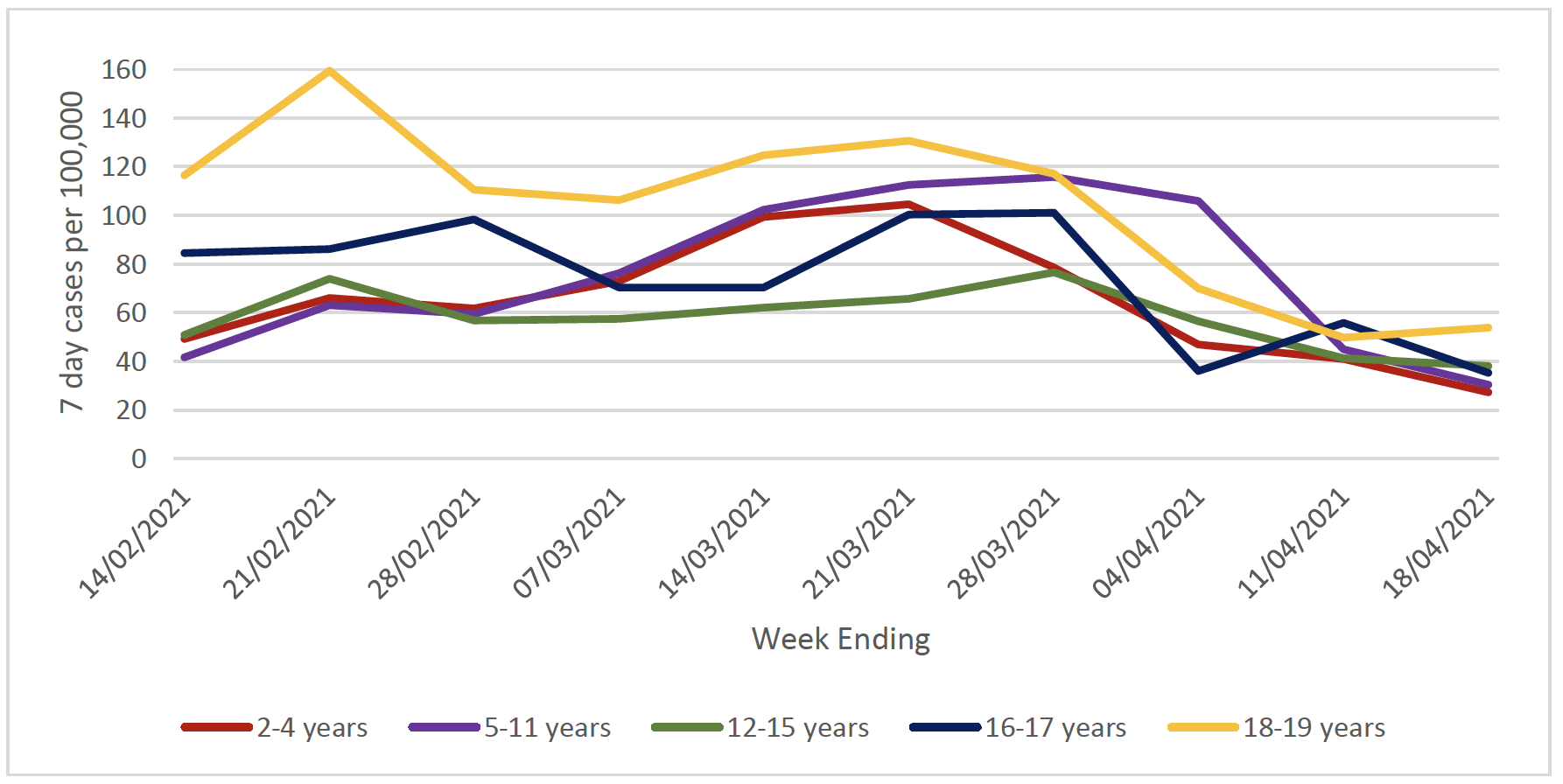
Image Description:
This figure shows the 7-day case rate of school pupils who tested positive for COVID-19, grouped in five age groups, during the period 14 February 2021 to 18 April 2021. The rates for all age groups have varied over time with a sharp increase in rates for the 18-19 age group in the middle of February. The rates for most age groups have decreased in the week to 18 April, with the sharpest fall in 7 day cases per 100,000 observed in those aged 16-17 and increased slightly amongst the 18-19 year olds.
Looking ahead
Changes in patterns of mixing and adherence to restrictions will impact on future case numbers. The Scottish Contact Survey measures times and settings that people mix where they could potentially spread Covid[2]. From this survey we can say that contacts are higher than seen during the lockdown period (averaging around 3 daily contacts) and have decreased slightly in the last two weeks, with a current level of 3.3 daily contacts. Contacts within the work and school setting have shown a decrease in the last two weeks by 24% and 78% respectively, coinciding with spring holidays that commenced from 26th March. Mean contacts within the 'other' setting (contacts outside of the school, home or work settings) have increased by approximately 34% over the same period. All age groups have shown an increase in contacts with the exception of those aged between 40 and 59. This increase in contacts is driven largely by increased contacts within the 'other' setting.
Self-reported compliance with the current regulations and guidance has decreased since January but remains at a high level. On 20-21 April, 69% of people reported 'complete' or 'almost complete' compliance.
Hospital bed and ICU occupancy are projected to fall over the next few weeks, but these both may plateau or increase as a result of schools reopening and other relaxations of non-pharmaceutical interventions (Figure 8)[2].
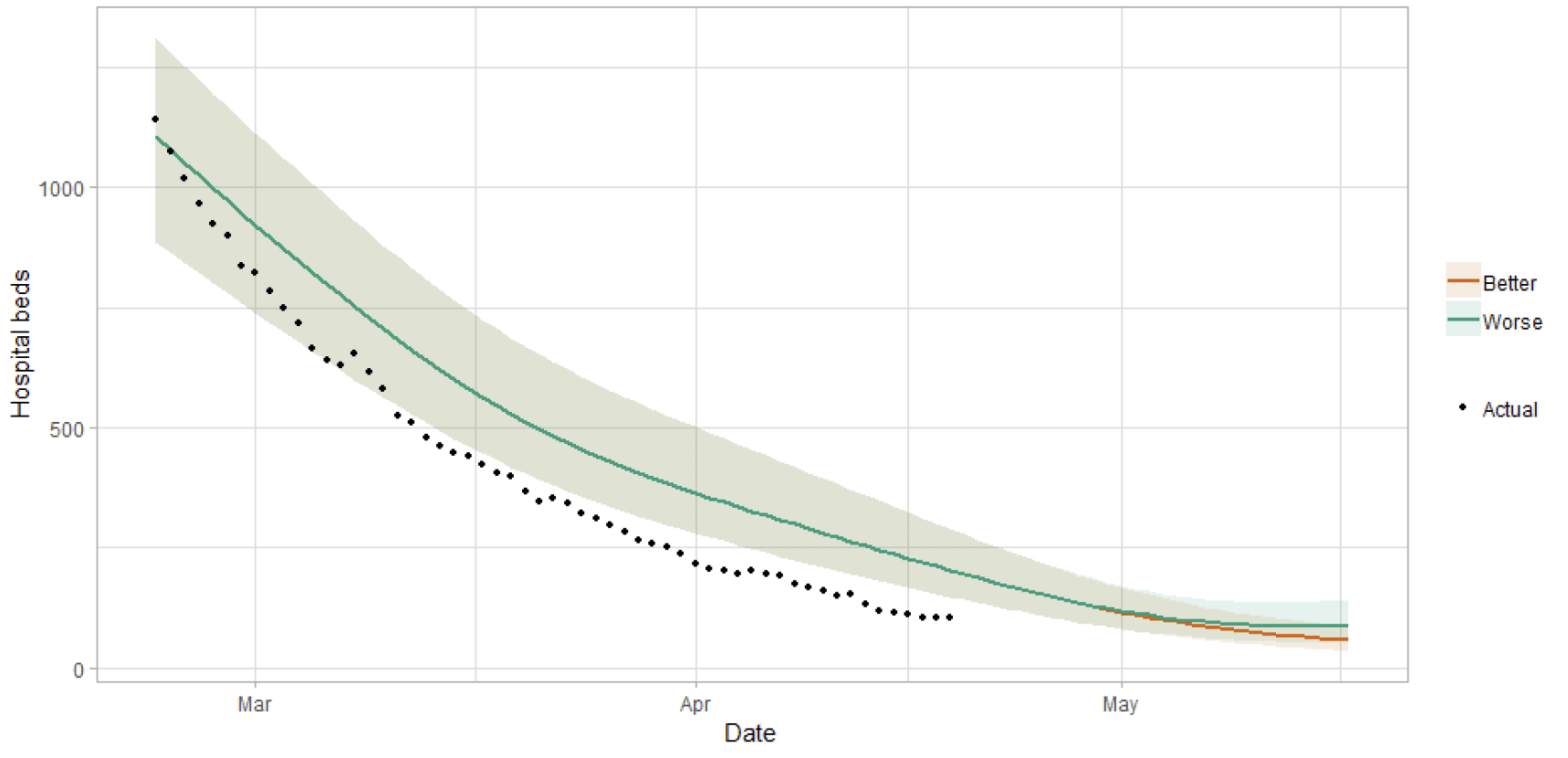
Image Description:
Figure 8 shows the projections of modelled demand for hospital beds required over time and displays a better and worst case scenario which are related to the success of the vaccine roll out. The actual number of beds required has been following the better case scenario so far with the projected demand to continue to fall in the next few weeks but may plateau or increase as a result of schools reopening and other relaxations of non-pharmaceutical interventions.
Vaccinations are continuing across the priority groups and almost 61% of the adult population in Scotland has now been vaccinated with the first dose[4]. The first vaccines were administered on Tuesday 8 of December and 2,755,175 had received their first dose by 22 April 2021, a 2% increase from the 15 April[3]. By the 22 April over 34,000 residents in care homes had received their first vaccination along with over 52,000 care home staff. In older adult care homes 90% of residents have now received their second dose. By age group, almost 100% of individuals aged 55+ and 91% of those aged 50-54 had received their first vaccination (Figure 9). 83% of the over 80s, 63% of those aged 75-79, and 43% of those aged 70-74 have received their second dose. Overall, 898,231 (almost 20%) of those aged 16 and over had received their second dose by 22 April[6]. There are continual decreasing hospitalisations and deaths among those groups vaccinated first (Figure 4).
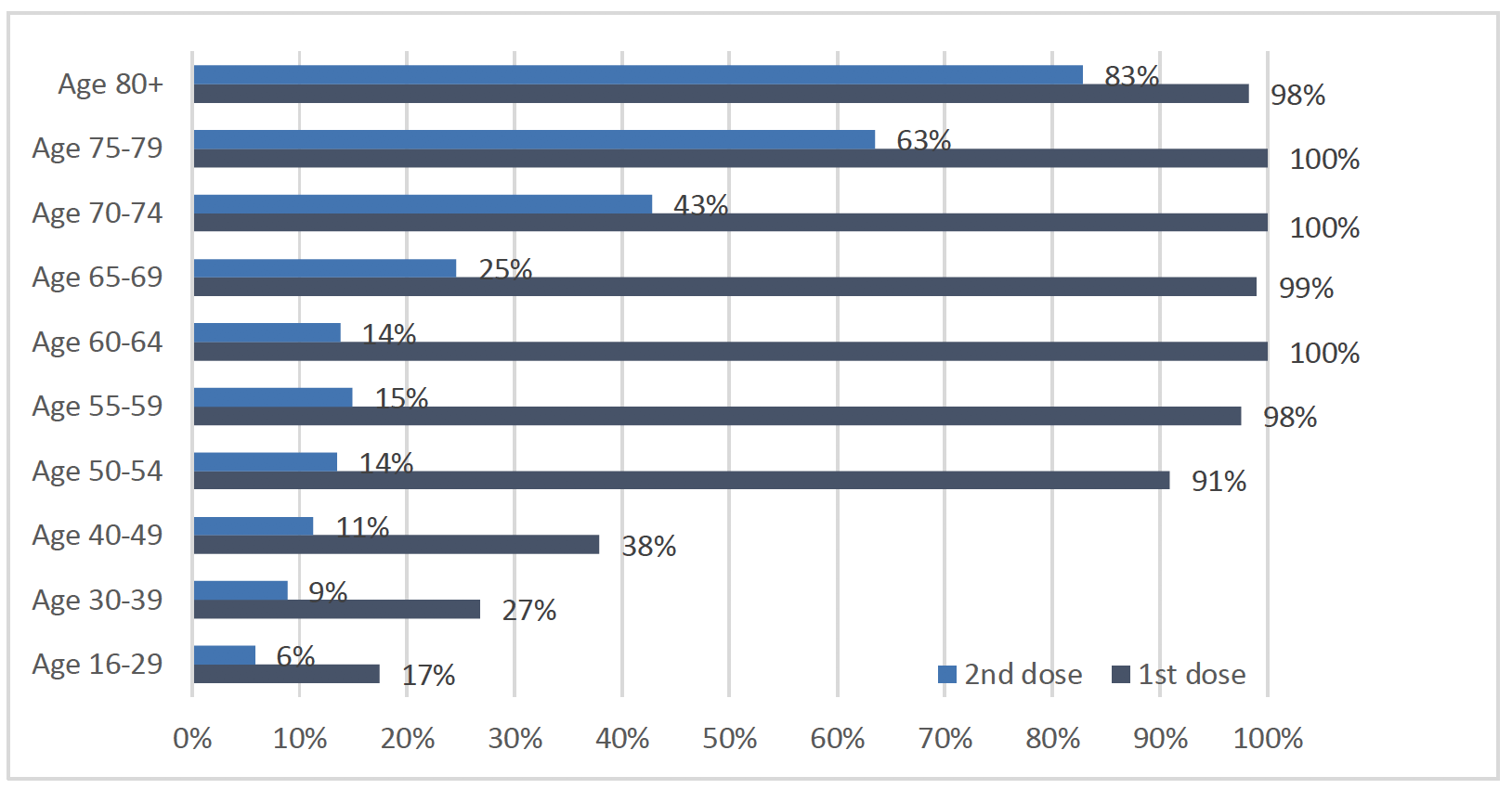
Image Description:
The first vaccines were administered on Tuesday 8 of December and 2,755,175 had received their first dose by 22nd April 2021, a 2% increase from the 15th April.
For the ten age groups identified, six groups have more than 98% vaccinated (everyone age 55+) and for age groups 60-64 and 70-79, 100%, for age group 50-54, 91%, have been vaccinated.
83% of over 80s have received their second dose by 22nd April.
The proportion of people surveyed who said they would be likely to be vaccinated for COVID-19 remains high. 63% of all respondents have already received at least their first vaccine dose. Of those not vaccinated, 67% report they are likely to be vaccinated when a vaccine becomes available to them.[14]
How the virus is changing
The variant of the virus commonly known as the UK variant (VOC-20DEC-01) has been increasing its share of confirmed cases since it was first detected in Scotland in mid-December and is now the dominant strain. This new variant of Covid is more transmissible[16]. It is likely that infection with this variant is associated with an increased risk of hospitalisation and death compared to infection with non-VOC viruses.[17]
Other variants of concern (VOCs) are being monitored by sequencing of SARS-CoV-2 samples. To date there are four VOCs and seven variants under investigation[18]. Up to 14 April, there have been 32 genomically confirmed cases of the variant VOC-20DEC-02 (first seen in South Africa) detected in Scotland. There have been 6 confirmed cases of the variant VOC-21JAN-02 (first identified from Brazil). There have also been a number of cases of other variants, which are currently under investigation, including 26 cases of VUI-21FEB-03 (first seen in Nigeria) and four cases of VUI-21APR-01 (first identified in India). There is some concern, that some of these new variants may partially escape immunity, from both natural infection and from vaccines currently being deployed, and we are monitoring the evidence on this .
Next steps
The Scottish Government continues to work closely with Public Health Scotland to monitor the course of the epidemic using several data sources. Each week this report will provide an overview of current COVID-19 situation in Scotland. This will include real time data on case rates, hospitalisations and deaths and how Scotland's figures compare to those from the rest of the UK. Modelling can tell us where the epidemic is likely to be heading. Local data and data by age group can highlight where problem arise, which can help in addressing some of these issues. In the coming weeks the roll out of the vaccine will continue to be monitored along with the impact of this on case rates and deaths among different age cohorts. Investigations are ongoing by NERVTAG, SPI-M, SAGE, Public Health England and Public Health Scotland regarding the impact of new variants and of vaccination, this will be reflected here as work is undertaken.
Contact
There is a problem
Thanks for your feedback